Page 1 of 2
Hallmarks on 16th-17th century pricket candlestick
Posted: Fri Apr 01, 2016 6:46 am
by Ancelmus
Hi,
Hereunder pictures show a small silver pricket candlestick, according to the type it should date from the late16th- early 17th century. It's small size (9cm height) indicates it's possibly a travel candlestick.
There are 3 marks to be identified; a crowned shield which looks like the Delft coat of arms, an oval shaped mark which is not clear and a 6.
Any info appreciated.
Thanks
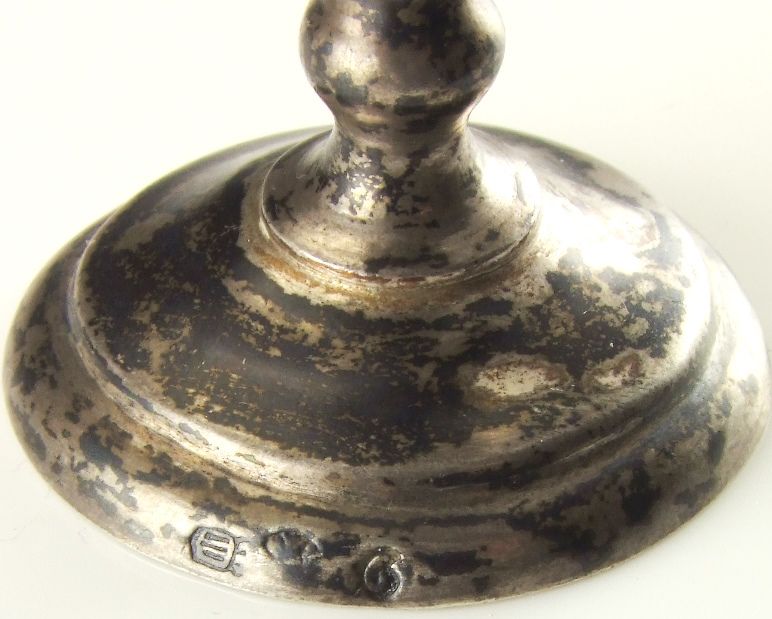
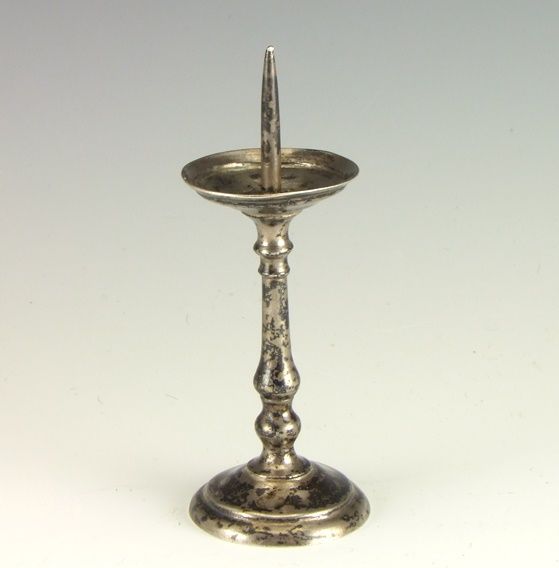
Re: Hallmarks on 16th-17th century pricket candlestick
Posted: Fri Apr 01, 2016 10:39 am
by Dendriet
Ancelmus wrote:
There are 3 marks to be identified; a crowned shield which looks like the Delft coat of arms, an oval shaped mark which is not clear and a 6.
I really miss the characteristic high crown in the city mark of Delft, but also the curvaceous lines of the shield.
Delft is known for its excellent quality.
But that's just my opinion
Best Regards
Dendriet
Re: Hallmarks on 16th-17th century pricket candlestick
Posted: Fri Apr 01, 2016 11:34 am
by Ancelmus
Thanks Dendriet,
I don't know much about the characteristics of the early marks and It might not be Delft, let's see what other experts come up with.The marks should contain the answers.
Re: Hallmarks on 16th-17th century pricket candlestick
Posted: Fri Apr 01, 2016 2:35 pm
by oel
Hi,
I believe it to be a set of spurious (fake) marks for Delft.
Best,
Oel.
Source; Valse Zilvermerken in Nederland K.A. Citroen.
Re: Hallmarks on 16th-17th century pricket candlestick
Posted: Fri Apr 01, 2016 3:12 pm
by Ancelmus
Hi Oel,
Did you find a picture of this marks in the mentioned book?
As this candle was found by a metal detectorist in the Netherlands and there is no doubt about it's authenticity. It was once in the collection of HJE van Beuningen.
Thanks
Ancelmus
Re: Hallmarks on 16th-17th century pricket candlestick
Posted: Fri Apr 01, 2016 7:25 pm
by oel
Hi Ancelmus,
Yes, I do believe spurious city mark Delft, based upon; K.A. Citroen, Valse merken in Nederland # 546&547, with fake year & maker's mark. And if I am wrong could it perhaps be German? Could you show us an image of the back of the candlestick's base?
Obsessed collectors, like Beuningen(R.I.P.) an avid collector, do have fakes in their collections. Regarding the candlestick marks, there must have been some doubt along the line otherwise why ask? I will move your question to other European countries.
Peter.
Re: Hallmarks on 16th-17th century pricket candlestick
Posted: Wed Apr 06, 2016 7:04 am
by Ancelmus
Hi Peter,
Enclosed a picture of the back of the candle. The base and stem are hammered together confirm the manufacture traits of the 16th century.
This candle could be made anywhere in Europe or UK as the known findspot is a Medieval trading city in Holland were artefacts and coins are found from Norway up to Italy and the UK.
My expertise are Medieval artefacts and coins, as silver artefacts from 16th C and earlier are very rarely found there's a gap here in my expertise.
Ancelmus
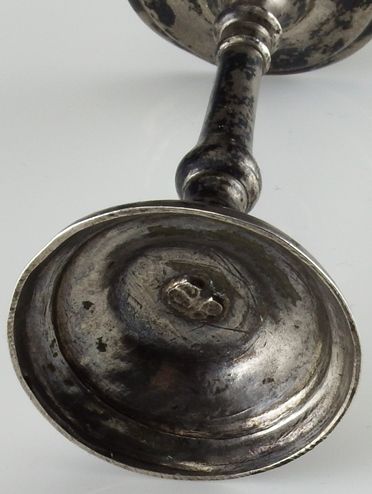
Re: Hallmarks on 16th-17th century pricket candlestick
Posted: Wed Apr 06, 2016 8:16 am
by AG2012

Hi,
Having seen spurious marks here, all pros and cons should be explored.
It`s claimed to be a metal detector find, meaning silver has spent decades in soil.
Patina seen on more common coins recovered by metal detectors varies depending on soil pH value, but it always adheres to silver.
Brown patina, or whatever impurity, should be evaluated (red arrow). Being a uniform deposit on silver it cannot be dirt of any kind.
Use cotton swab soaked in absolute ethanol and try to clean brownish areas. Patina cannot be removed doing this. On the other hand, if removed by gentle rubbing it would mean organic substance (grease) that could not have survived having been buried for ages.
Metal detecting has become a profitable business. The worst example is to bury a handful of moderately valuable Roman bronze artifacts in areas known to collectors, and then rent vacant lots to enthusiasts who spend holidays desperately searching for more valuable items after having easily found planted artifacts. Bed and breakfast is, of course, offered by the owner of the lot.
'Beware the metal detectorist bearing gifts'
Re: Hallmarks on 16th-17th century pricket candlestick
Posted: Wed Apr 06, 2016 9:36 am
by Ancelmus
Hi,
Agree pros/cons have to be explored.
Patination is a study on itself. I would like to add next to pH of the soil, the amount of oxygen in the soil has an effect as well.
There are areas in Holland were circumstances in >1 m depth are practically oxygen free. Medieval Pewter can come out shining as silver when found and wood and iron still well preserved.
I normally never clean coins or artefacts with chemicals, just rinse with water and use some acid free vaseline. But i tried to clean a tiny bit at the red arrow with benzene and nothing changed.
I know fake (paint based) patination like on Roman coins from the Balkans (1990's) can be removed by acetone, nowadays these fake patinations are acetone proof...
The brownish and black patination on the candle are very common to me, enclosed a picture of a 17th c silver rijderschelling (58.3% silver contents) to show what bad soil circumstances can do.
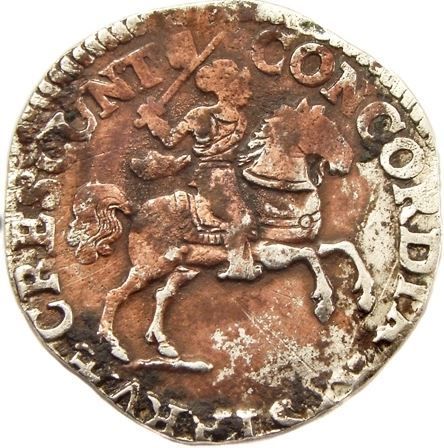
Re: Hallmarks on 16th-17th century pricket candlestick
Posted: Wed Apr 06, 2016 1:20 pm
by AG2012

This is the closest so far.
Belgium, Mechelen (Rosenberg, IV Band, page 109)
Town mark for the year 1790 is practically the same.
Date letter on far right (the third mark) is poorly struck, left half is missing but its shape looks identical with date mark for 1791. Of course, the second digit is ``0`` for 1790 described as `` 90 under the crown``.
Re: Hallmarks on 16th-17th century pricket candlestick
Posted: Thu Apr 07, 2016 6:30 am
by Dendriet
Ancelmus wrote:Hi,
There are 3 marks to be identified; a crowned shield which looks like the Delft coat of arms, an oval shaped mark which is not clear and a 6.
Dendriet wrote:
I really miss the characteristic high crown in the city mark of Delft, but also the curvaceous lines of the shield.
Delft is known for its excellent quality.
But that's just my opinion
Best Regards
Dendriet
AG2012 wrote:
Hi,
Having seen spurious marks here, all pros and cons should be explored.
An explanation on the “pseudo marks”
It was initially my need to show that it was not the city Mark of Delft
It would have been better if I had shown through pictures, so it was much clearer
Place them now, so that all suspicions of “pseudo mark” is no longer an issue.
I think Oel would have the same opinion

Pseudo Marks 581, 582
AG2012 continued his research and found city mark Mechelen as a suitable candidate.
I did research into the Belgian books including Belgian hallmarks of R. Struyck
Unfortunately not always correct or complete in their presentations
Look at: Franciscus Dossche Francis (4491)
Note number 4491 as makers marks in a flaming heart (religious)

My first thought was that this candlestick was part of the last Sacrement (-sacrament of Dying -) The holy oil (with two silver Holy oil containers)
The maker's mark is about that period but no further announcement is made.
I am not one hundred percent sure, but it wanted to share with you.

Re: Hallmarks on 16th-17th century pricket candlestick
Posted: Thu Apr 07, 2016 5:42 pm
by oel
Hi Ancelmus, AG2012 & Dendriet, thanks for the team work!

Nice litte candlestick made in Mechelen (9 cm tall)
 Not for Delft and no pseudo/fake marks.
Not for Delft and no pseudo/fake marks.
Yes, I am using the book;
Belgische Zilvermerken van R. Stuyck and checked for
Mechelen and had problems to find a good match for the marks on the candlestick and did not persue.

I never checked Mark Rosenberg's volume IV Band and indeed good old Rosenberg shows a match. I forwarded the images to Museum voor Edelsmeedkunst, Juwelen en Diamant in Antwerpen
http://www.tento.be/musea/museum-voor-e ... en-diamant
The Senior advisor of the museum, at first look, confirms Mechelen year 1791. Next week the Museum will be able to study the candlestick in detail and hopefully we will be able to give more information.
Regarding the maker's mark; could you please try to clean(soft toothbrush and little silverpolish, rinse with water & soap) and provide us with a better enhanged image?
Best,
Peter
Re: Hallmarks on 16th-17th century pricket candlestick
Posted: Fri Apr 08, 2016 8:34 am
by Dendriet
Thanks for your reply, I am curious whether this little candlestick as a component for the use of a "Chrismatorium"
Kind regards
Dendriet
Re: Hallmarks on 16th-17th century pricket candlestick
Posted: Sun Apr 10, 2016 3:25 pm
by Ancelmus
Hi Peter, AG2012 & Dendriet - Big thanks for your effort and teamwork ! We are certainly getting closer.
@ Peter; Slight cleaning of the marks did not improve much as the black takes care for some contrast.
I have added the new picture. I used a little toothpaste (old grandfathers tip..) works great on silver.
When looking at the Middle clearly oval shaped mark with magnifying glass I have the impression it shows a bust/face to right.
@AG2012; yes Mechelen - you found it !
@Dendriet; The candle could be 'born' as Chrismatorium and made to a candle later on. I keep the possibilities open.
Best regards,
Ancelmus
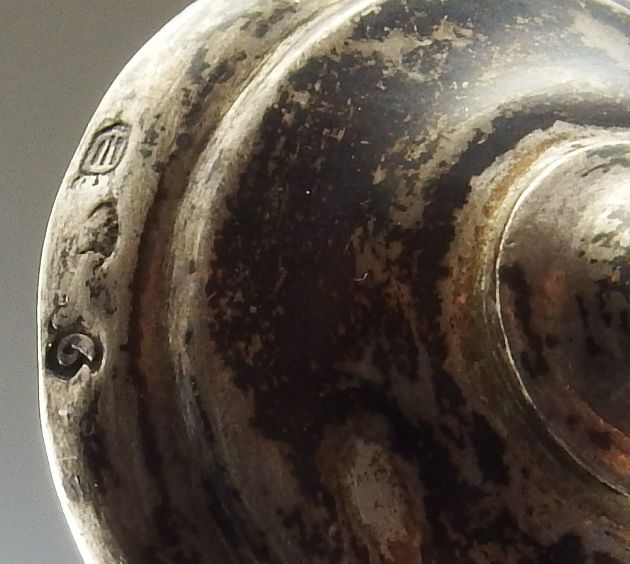
Re: Hallmarks on 16th-17th century pricket candlestick
Posted: Sun Apr 10, 2016 4:38 pm
by Dendriet
What you see as a bust facing right is the flaming heart.
When using such images have to deal more or less with a silversmith for religious affairs.
This little candleholder is in my view, part of a religious use retueel and my thoughts go out to then sacraments to dying or births.
Forget what you think is made with / from something else
It's either a thumbnail (miniatuur) or what I describe.
Excuse me for my english.
I will be as good as I can an attached photo (very difficult to catch because it is small portrayed in the book)
Let me know if the image is what you see conformity

Re: Hallmarks on 16th-17th century pricket candlestick
Posted: Mon Apr 11, 2016 4:09 am
by AG2012
I am not very familiar with religious rites, but priests typically carry miniature versions of these items in their sick call kit.
But let`s not reject the idea of it being meant for
secular use. There were pricket chamber sticks of this kind made of various metals.
The candle could be 'born' as Chrismatorium and made to a candle later on.
I do not understand this; transformed from what?
Regards
Re: Hallmarks on 16th-17th century pricket candlestick
Posted: Tue Apr 12, 2016 10:31 am
by Ancelmus
I meant the possibility that when the item was made it could have been without the pricket and used as Religious bowl for oils.
Re: Hallmarks on 16th-17th century pricket candlestick
Posted: Tue Apr 12, 2016 1:03 pm
by Dendriet
Re: Hallmarks on 16th-17th century pricket candlestick
Posted: Tue Apr 12, 2016 4:08 pm
by oel

Hi Dendriet, AG2012 & Ancelmus,
Based on top image.
The Head collection & research DIVA Antwerp Home of Diamonds would date the candlestick for 1766 and the symbol in the master’s mark could be described as an eye. Strangely but this mark is linked to Gerard van Lier (1744-1819), who also used a mark with his initials VL, and to Michiel van der Plas (
Source; G. Van Doorslaer, La corporation et les ouvrages des orfèvres malinois, p . 147 , biographies p . 163 and 167)
So, the question marks remain .
This altar candelabrum was probably part of an edifying educational toy set that could be used by children.
Best,
Peter
Re: Hallmarks on 16th-17th century pricket candlestick
Posted: Tue Apr 12, 2016 5:21 pm
by Dendriet
________________________________________________________________________________________
First of all, my congratulations to Ancelmus for his great find, and that this had been once in the collection of HJE van Beuningen (Museum Boijmans van Beuningen ??)
My compliments to AG2012 for his great discovery that it eventually comes from comes from Mechelen (Belgium)
I'm happy with the result that the candlestic has now a place where it should be.
My compliments Oel for the good work you have done to realize this result.
Best Regards
Dendriet











